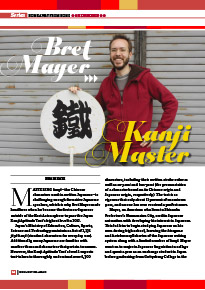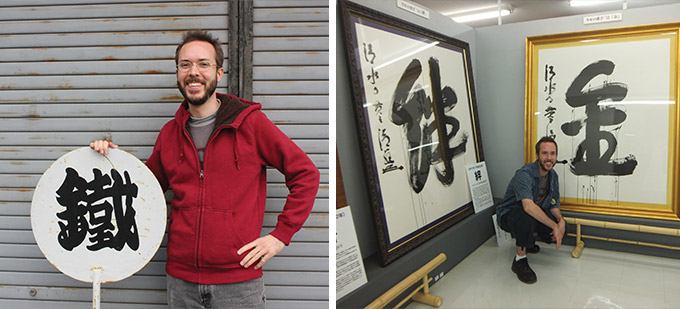Home > Highlighting JAPAN >Highlighting Japan January 2015> Japanese Abroad
Highlighting JAPAN

Home Away From Home
Bret Mayer
Kanji Master

Mastering kanji—the Chinese characters used in written Japanese—is challenging enough for native Japanese speakers, which is why Bret Mayer made headlines when he became the first non-Japanese outside of the East Asian sphere to pass the Japan Kanji Aptitude Test’s highest level in 2012.
Japan’s Ministry of Education, Culture, Sports, Science and Technology maintains a list of 2,136 jōyō kanji (standard characters for everyday use). Additionally, many Japanese are familiar with another thousand characters that pertain to names. However, the Kanji Aptitude Test’s level 1 expects test-takers to thoroughly understand over 6,300 characters, including their written stroke order as well as on-yomi and kun-yomi (the pronunciation of a character based on its Chinese origin and Japanese origin, respectively). The test is so rigorous that only about 11 percent of examinees pass, and no one has ever received a perfect score.
Mayer, an American who lives in Shizuoka Prefecture’s Hamamatsu City, credits Japanese animation with developing his interest in Japanese. This led him to begin studying Japanese on his own during high school, learning the hiragana and katakana syllabaries of the Japanese writing system along with a limited number of kanji. Mayer went on to major in Japanese linguistics in college and spent a year as an exchange student in Japan before graduating from Gettysburg College in the U.S. in 2004. He then returned to Japan for serious language study in 2008.
The now 32-year-old Mayer began his kanji testing experience with level 8 that year, taking the exam in a small room, surrounded by elementary school students. The demographics had changed considerably by the time level 1 came around. “Retired people, kanji maniacs, and the random child prodigy,” is how he describes his fellow test-takers.
Level 1 proved challenging. “The first time I tried level 1, I only got 7 points out of 200 correct,” Mayer admits. Yet rather than feeling resigned, he reflects that it helped eliminate the mystique of the test. He started studying for at least three hours a day, increasing that to six as the test day drew near. Mayer finally passed level 1 on his fifth try in October 2012. His home bears witness to his extraordinary effort: over sixty notebooks full of characters, readings and meanings just for the pre-level 1 and level 1 exams.
To Mayer, writing kanji is an art, and he says he appreciates the story each one has to tell. His favorite kanji, 魁 (sakigake, meaning “forerunner” or “pioneer”), represents his philosophy of pursuing something no one else has done. “People had always told me not to bother with level 1, that it wasn’t necessary, so that’s what made me want to try it,” he explains.
Mayer hopes Japanese and foreigners alike will notice the beauty of kanji. He appears weekly on a Shizuoka radio program to talk about kanji and their meanings, and is very excited about developing a short TV program in which he introduces interesting kanji. “This is something I’ve always wanted to do,” he says. Mayer is also a certified instructor at the Japan Kanji Aptitude Testing Foundation, and estimates he’s taught or lectured to over five hundred students.
In addition to his perpetual quest to discover rare kanji wherever he travels around Japan, Mayer is now studying for a test on Japanese proverbs as well as taking a different approach to the Kanji Aptitude Test: “My next goal is to achieve perfect scores.” Mayer has already sailed through levels 10, 9, and 8 without a mistake, so it may just be a matter of time before he makes the news again for acing level 1.
© 2009 Cabinet Office, Government of Japan






